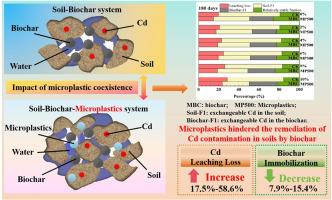镉在土壤-生物炭-微塑料体系中的吸附、固定化机理及潜在风险
IF 8.4
2区 环境科学与生态学
Q1 ENVIRONMENTAL SCIENCES
引用次数: 0
摘要
农业土壤中镉和微塑料复合污染问题日益突出。然而,生物炭修复重金属污染土壤的研究往往忽视了微塑料的影响。本研究探讨了在含有不同百分比(0%、2%、4%、6%、8%和10%)500目聚乙烯微塑料(MP500)的土壤中生物炭对Cd的吸附和固定化。此外,还研究了生物炭在土壤中对Cd的定量吸附机理。结果表明,当土壤中MP500的含量从0%增加到10%时,生物炭对Cd的吸附量持续增加1.5% ~ 33.1%。然而,较高的MP500浓度也导致更多的Cd浸出到环境中(持续增加,17.5% - 58.6%),并导致土壤-生物炭样品中相对稳定Cd的比例降低(持续下降,7.9% - 15.4%)。这表明微塑料干扰了生物炭对土壤镉污染的修复效果。在吸附机制方面,土壤中MP500的百分比越大,生物炭的矿物机制百分比越大。研究结果表明,与土壤中的Cd相比,微塑料吸附的Cd对农业土壤环境的威胁更大;在生物炭治理镉污染的实际应用中,应特别注意微塑料的影响因素。本文章由计算机程序翻译,如有差异,请以英文原文为准。

Adsorption, immobilization mechanisms and potential risks of Cd in soil-biochar-microplastics system
The problem of cadmium (Cd) and microplastic compound contamination in agricultural soils is becoming more and more prominent. However, research on biochar remediation for heavy metal-contaminated soils often overlooks the impact of microplastics. This investigation explored Cd adsorption and immobilization of biochar in soils containing varying percentages (0 %, 2 %, 4 %, 6 %, 8 %, and 10 %) of 500-mesh polyethylene microplastics (MP500). Additionally, it examined the quantitative Cd adsorption mechanisms of biochar in the soil. The findings revealed that the Cd adsorption capacity of biochar continuously increased 1.5 %–33.1 % as the percentage of MP500 in the soil rose from 0 % to 10 %. However, higher MP500 concentrations also led to greater Cd leaching into the environment (continuously increased, 17.5 %–58.6 %) and a reduction in the proportion of relatively stable Cd (continuously decreased, 7.9 %–15.4 %) in soil-biochar samples. This suggested that microplastics interfered with biochar's effectiveness in remediating Cd contamination in soils. For adsorption mechanisms, the larger the percentage of MP500 in the soil, the greater the percentage of mineral mechanism of biochar. This study highlighted that Cd adsorbed on microplastics was a greater threat to the agricultural soil environment compared to Cd in soils; microplastics should be paid special attention to as an influencing factor in the practical application of biochar for the management of Cd pollution.
求助全文
通过发布文献求助,成功后即可免费获取论文全文。
去求助
来源期刊

Journal of Environmental Management
环境科学-环境科学
CiteScore
13.70
自引率
5.70%
发文量
2477
审稿时长
84 days
期刊介绍:
The Journal of Environmental Management is a journal for the publication of peer reviewed, original research for all aspects of management and the managed use of the environment, both natural and man-made.Critical review articles are also welcome; submission of these is strongly encouraged.
 求助内容:
求助内容: 应助结果提醒方式:
应助结果提醒方式:


